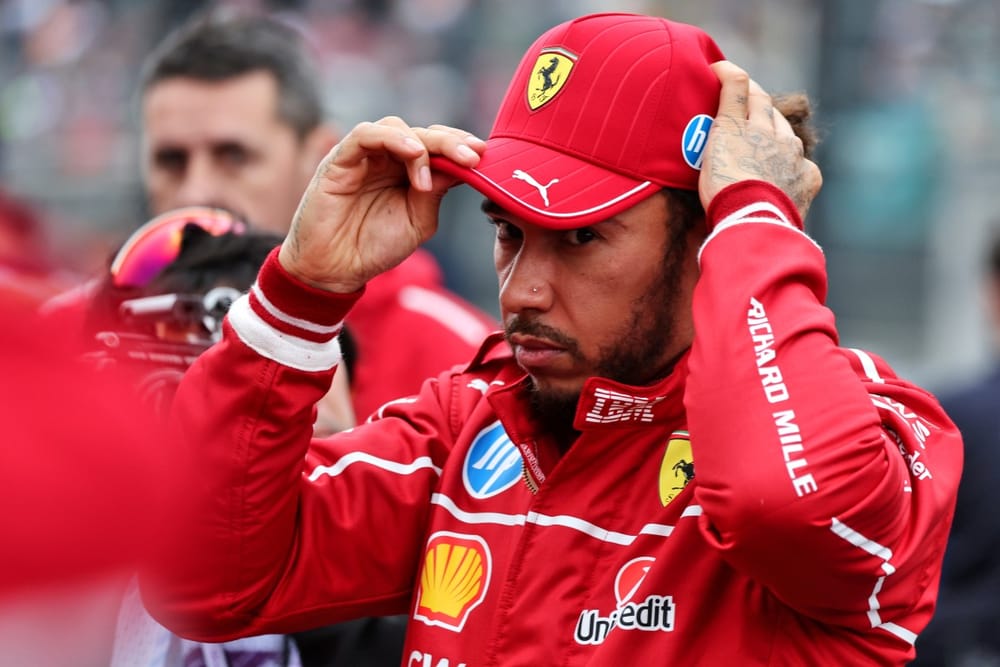The image of Lewis Hamilton’s scarlet Ferrari, mangled and motionless against the barriers at Zandvoort, sent a predictable shockwave through the world of Formula 1.
Crashes are a brutal, yet inherent, part of the sport. But as the dust settled and the replays rolled, a narrative far more complex and damaging than a simple driver error began to emerge.
This was not just about a loss of grip on a treacherously damp track; it was about a loss of communication, a breakdown of trust, and the deafening silence from a team that, in that critical moment, appeared to abandon its star driver.

The incident, on its face, was a mistake. A light drizzle had begun to slick the tarmac, a notoriously difficult condition for drivers to navigate. Yet, as analysis of team radio later revealed, the moments leading up to Hamilton’s crash were starkly different from those of his competitors. Teams like McLaren and Red Bull were a flurry of activity, their radios crackling with warnings about the changing conditions, advice on brake balance adjustments, and strategic guidance. They were proactive, engaged, and supportive, arming their drivers with the information needed to survive the evolving challenge.
From the Ferrari pit wall to Lewis Hamilton? Silence. A lethal, inexplicable silence. There were no warnings about the rain-soaked kerbs, no suggestions for adapting the car’s setup, no cautionary words to temper his aggression. He was a lone warrior, flying blind into a predictable hazard, and the consequences were severe. This silence was not a mere oversight; it was a symptom of a deeper, more corrosive problem brewing within the hallowed halls of Maranello.
To understand the gravity of this failure, one only needs to look at the treatment of Hamilton’s teammate, Charles Leclerc. The data from Leclerc’s car, showing a similar loss of grip, prompted an immediate and decisive reaction from the Ferrari strategists. He was called into the pits, given clear instructions, and supported with a coherent plan. When Leclerc later had his own incident, born from aggressive racing in close quarters rather than pit wall neglect, the team’s response was one of immediate support and solidarity. The garage rallied around him, a fortress of red shielding their driver from blame.
For Hamilton, the aftermath of his crash was a chilling study in contrasts. As he climbed from his wrecked machine, the expected words of reassurance from his race engineer never came. Instead, the garage was a tomb of silence. Mechanics reportedly avoided eye contact, their faces grim and unreadable. His engineer, the crucial link between driver and team, remained fixated on the monitors, seemingly more concerned with data than the man who had just endured a high-speed impact. It was a cold, isolating reception that spoke volumes. This wasn’t just a team dealing with a crash; it was a team fractured, its loyalties visibly divided.
This incident has ripped the curtain back on what many insiders describe as a dangerous dual philosophy operating within Ferrari. On one side, with Charles Leclerc, the approach is one of calculated conservatism. The strategy is designed to mitigate risk, secure valuable points, and protect their homegrown Monegasque talent. He is the safe bet, the long-term investment being carefully nurtured. On the other side, with the seven-time world champion Lewis Hamilton, the philosophy appears to be one of aggressive, high-stakes gambles. They trust his legendary pace, his ability to work miracles, and push aggressive strategies like the undercut, often leaving him exposed with little margin for error.
In stable conditions, this split approach can yield results. But in the chaotic, rapidly changing environment of a damp Zandvoort, it proved to be a catastrophic failure. The hesitation created by this split-decision chain, the lack of a single, unified strategic voice, left Hamilton vulnerable. The team was paralyzed by its own internal division, unable to make the swift, decisive call that could have saved his race.

The consequences of this single crash extend far beyond a disappointing race result. The loss of crucial constructor points has significantly shrunk Ferrari’s buffer over its rivals, putting their championship aspirations in jeopardy. More personally for Hamilton, he now finds himself a staggering 42 points behind Leclerc in the intra-team battle. Compounding this is the fact that all five of Ferrari’s podiums this season have been secured by Leclerc, a statistic that paints a grim picture of Hamilton’s integration into the team.
This creates a severe political dilemma for Ferrari’s management. Do they continue to pursue this fractured strategy and risk further disastrous miscalculations? Or do they formally prioritize Leclerc, effectively alienating a driver of Hamilton’s caliber and creating a toxic atmosphere of resentment and distrust? There is no easy answer, and the path they choose will define their season.
For Hamilton, a consummate professional who has always presented a calm and collected public facade, the incident is said to have been a breaking point. Sources close to his camp describe him as being privately “livid,” not at the crash itself—he understands the risks of racing—but at the profound sense of abandonment. The silence from his team was a betrayal, a confirmation of his fears that he is not being supported in the same way as his teammate. He is an outsider in his own garage, an icon left to fend for himself.
The silence that followed Hamilton’s crash at Zandvoort will echo throughout the remainder of the season. It was more than an absence of words; it was the sound of a team breaking apart at the seams. It exposed a dangerous flaw in Ferrari’s structure, a deep-seated indecision that favors one driver while sacrificing the other. It was the moment that a simple racing incident became a symbol of a championship campaign on the verge of imploding, not because of a lack of speed, but because of a failure to communicate, a failure of trust, and a failure to stand united as one team.






